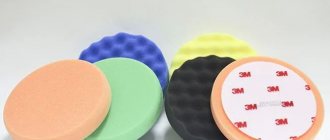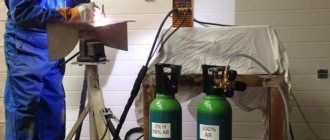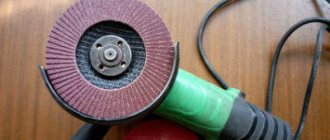Application of cutting discs for metal
Certain wheels are used when cutting samples of varying degrees of hardness. It could be:
- brick;
- concrete;
- metal;
- granite, difficult to cut.
How to choose cutting discs for an angle grinder for metal
You can also perform grinding at any level, stripping metals, cleaning surfaces from paint, corrosion and adhesives.
Cutting discs can be selected for small, medium and large grinders. When choosing, the main attention should be paid to the selection of external and internal diameters. The depth of the cut will depend on the size of the circle.
Cutting wheels for metal
Also important is the number of teeth – cutting segments, which varies from 24 to 100 and is responsible for the cutting speed. The greater the number of teeth, the higher the speed.
When cutting metal, discs with a diameter of 200–300 mm are most often used. They are used for cutting aluminum and steel profiles, sheet steel, fittings and non-ferrous metals.
How to choose the right disc for an angle grinder
Wheels for grinders can be purchased in retail chains in a varied assortment and at reasonable and high prices. With the help of products made from different materials and using different technologies, diverse operations are performed. What are the basic selection rules and what to pay attention to? It is necessary to clearly know what materials you will be working with. You also need to pay attention to the following factors:
- diameter and thickness (indicators should not be greater than indicated in the passport data for the angle grinder or, more simply, the disc must fit into the protective casing);
- seat size (must correspond to the diameter of the grinder spindle);
- rotation speed (it must correspond to the type of grinder, indicated on the disk itself);
- type of cutting (dry, wet or combined).
The rules that must be followed to make products last longer are simple. For hard materials, choose discs with a soft binding, for soft ones – with a hard one. The work area should not overheat during operations. Therefore, it is recommended to periodically remove the disc from the material to allow it to cool. You cannot make deep cuts in one pass. Do not press the product with great force and work at high speeds. Remember: if during operation the disc experiences beating or cracks appear on it, you cannot cut with this consumable. It needs to be replaced.
The video explains in detail and clearly about grinder wheels:
We ask those who have encountered discs for grinders, made their choice and worked with specific models, to share their experience in the comments to the text.
Popular manufacturers and high cost of discs
Prices for consumables for grinders vary from the lowest - about 20 rubles, to several thousand rubles. The high cost directly depends on the manufacturer and what material will be used. The current market is rich in choice of manufacturers, both domestic and foreign.
Bosch
German company, a leader in the production of power tools and related materials. A wide variety of attachments for grinders: diamond and abrasive cutting wheels for stone, metal and wood. The company's products comply with ISO.
Characteristics of Bosch circles on the front of the disc
FIT
Canadian manufacturer of tools for professional and household use. The range includes a wide selection of cutting discs for metal and stone.
Dremel
American company. Produces high quality power tools. There is also a wide selection of attachments for grinders:
- cutting wheels for metal, wood and plastic;
- with diamond coating on concrete, marble, ceramics and porcelain.
Husqvarna
A Swiss company known for its high performance and durability of products. We offer a wide selection of cutting diamond and abrasive discs. The negative point is the high price.
MESSER
Korean manufacturer. A wide range of attachments for grinders:
- carbide wheels for high carbon steel;
- segmented diamond for concrete and asphalt;
- discs for cutting ceramic products, porcelain stoneware and marble.
Zubr
Russian company. Manufactures power tools and cutting equipment. Wide selection of universal attachments for grinders.
Hitachi Power Tools, Luga Abrasiv Extra
. Excellent price-quality ratio. In the assortment you can find budget options, which does not affect the quality of the products.
Cutting wheels for grinders: the right choice for safe work
Almost all construction electric tools are multifunctional, and they owe these special attachments, each of which has its own properties, technical characteristics, and purpose. For example, numerous drill bits for drills, hammer drills, as well as different types of cutting wheels for an angle grinder (angle grinder) or “grinder”, as users also call it.
This name appeared in the seventies of the last century, when the first samples of such an instrument were produced in Bulgaria. Equipped with a powerful motor, such a machine naturally performs not only a grinding function, it cuts and processes hard materials - metal and stone.
Types of cutting discs
Among my readers, there are probably people who are preparing to buy an angle grinder, as well as those who have already purchased the tool and are trying to figure out the attachments. I want to help everyone at once, simplify the task and tell you about the numerous cutting wheels, which are the most popular attachments of this machine, which, quite possibly, you will have to buy additionally.
To do this, you need to find out what kind of work is performed with the participation of an angle grinder, and the types of attachments used for them. More than 70% of all actions performed by an angle grinder are cutting work. It cuts almost any material: from metal to wood, but when choosing, be sure to read the instructions, since there are tool models and cutting wheels that do not perform certain functions, for example, cutting stone.
Cutting discs are divided into abrasive and diamond . The most commonly used are abrasive cutting wheels for metal and stone. How to find the right option for you among them?
When you pick up a cutting wheel, you will find quite a lot of information on its front side. Firstly, you will see a specific specialization of wheels, since they are intended not only for steel, but also for other materials, including non-ferrous metals, as well as for cast iron, stone, and porcelain stoneware. There are also universal options.
Also here you will see data on maximum operating speeds, shelf life of the cutting wheel, dimensions, and also specifications.
Cutting wheel sizes
The circle label indicates the outer diameter and the inner (fitting) diameter, which is often 22.2 millimeters. The outer diameter must be selected in accordance with the class of the angle grinder, for example: 115, 125, 150, 180 or 230 mm. Never install a cutting wheel with a larger diameter than required on an angle grinder; this is fraught with danger.
The thickness of the disk greatly influences the choice, since its use for a certain type of work depends on it. The standard thickness is 2.3 - 2.5 millimeters with a diameter of 125 millimeters. Carefully, quickly and quite easily work with thin circles (1-1.2 mm), while the material heats up less. However, thin discs wear down intensively. To reduce abrasive wear, select the thickness of the disc in accordance with the thickness of the metal being cut, then the work will be more productive and longer lasting.
(thin Lug disk on metal)
When working with thin circles, follow the rules especially carefully. Although the abrasive material of the metal cutting wheel is reinforced with a reinforced mesh using a special technology, nevertheless, never remove the protective casing from the grinder, wear special clothing, and do not press the wheel with force. By following all the standards, you can safely cut sheet metal, pipes, profiles of various configurations, corners, and fittings in thin circles.
How to determine the shelf life of a cutting wheel?
Let's look at what this inscription on the label means: V 04/ 2016. Usually it is stamped on a metal ring around the mounting hole. This designation indicates the quarter and year until which the disc can be used. Everything is clear with the year, and the quarter is designated by its first month: V 01 (January) - 1st quarter, V 04 (April) - 2nd quarter, and so on. For safety reasons, do not buy expired goods, do not leave disks lying around at home idle, purchase them in time for work.
Marking of cutting wheels
We can talk for a long time about the specifications and markings of cutting wheels, but some manufacturers have tried to describe everything in detail on their websites, providing information for certain types of wheels. Therefore, we will look at one example of how to decipher the four-digit code indicated on the label.
The four-digit code “A 30 S BF” means: A - electrocorundum (abrasive grain material). If the designation is AS, then this is white electrocorundum, purified from chlorine, sulfur and iron, which is important for cutting stainless steel. Designation C - silicon carbide - grains for stone cutting wheels. Number 30 (sometimes 24) - large grains for cutting steel, for non-ferrous metals - 40 or 60.
The next symbol, in this case S, indicates the hardness of the ligament. The higher the serial number of the symbol in the alphabet, the harder it is. One point is important here: you need to choose the ideal ratio of the hardness of the bond and the strength of the metal being cut, since they have an inverse relationship.
During cutting, grains that have become dull should fall off and crumble, giving way to whole cutting particles of abrasive. But if the bond is too hard, then the cutting wheel, as experts say, “gets greasy,” begins to cut poorly, and overheats the workpiece. If the ligament is too soft, the disc will quickly wear off.
And the last code designation - BF - is bakelite - a material that binds abrasive grains.
Cutting disc for stone
Diamond cutting and abrasive discs for grinders cope with tasks such as cutting and processing concrete, porcelain stoneware, stone, and asphalt. It is well known that diamond is the leader on the hardness scale, so the ends of cutting steel discs for dense materials are coated with diamond chips mixed with metal particles.
Diamond blades for materials of different hardness can be sectional - for slate, brick, tiles, marble, as well as non-sectional - for granite, concrete, stone. When choosing them, decide what material you are going to work with. The thickness of diamond discs is 1.3 - 2.2 mm.
Abrasive cutting wheels are universal; they cut not only metal, but also stone. They are made by pressing several layers of fiberglass mesh with an abrasive mass, followed by baking in an oven. There are also cutting wheels without reinforced mesh, but they are not used for working with a manual grinder. It is the mesh that reduces the risk of disc rupture at high rotation speeds.
Cutting wheels have a high rotation speed, so safe operation is guaranteed by the high quality of their manufacture by well-known manufacturers and mandatory certification. Our store presents products from well-proven brands, Bosch, ISMA, Makita and others.
Diamond blades cut denser materials, such as stone, and wear out more slowly than abrasive blades, but the latter have their advantages. Abrasive wheels have the property of self-sharpening, although due to a reduction in diameter, and also do not require forced water cooling; they are cooled naturally due to the large number of pores between the abrasive particles. Therefore, the temperature during operation of abrasive wheels does not exceed 70-80°C. Among diamond blades there are models that are designed for dry cutting.
To prevent consumers from making mistakes when choosing cutting wheels, color coding has been introduced. For abrasive wheels, green corresponds to cutting on concrete, blue - on metal. For diamond blades, green indicates granite, orange indicates brick, yellow indicates tiles and alabaster, blue indicates concrete and marble, and gray indicates tiles and porcelain tiles.
When choosing a circle for cutting stone, consider the following parameters:
- correspondence of the size and type of abrasive grains to the hardness of the material;
- correspondence between the rotation speeds of the wheel and the angle grinder spindle;
- permissible diameter of the cutting disc for your angle grinder.
Such a seemingly simple job as cutting stone is only possible with strict adherence to safety rules:
- securely fix the cutting wheel on the machine spindle with a special key;
- be sure to use personal protective equipment and a respirator when working;
- Guide the wheel exactly along the cutting line to avoid jamming and possible injuries;
- do not remove the protective cover from the angle grinder;
- do not stand in the plane of rotation of the disk while cutting;
- securely fix the material being processed and hold the angle grinder with both hands.
The key to productive and safe work with cutting wheels will be a wise choice and compliance with all the rules. Construction season is coming soon, when the use of power tools, including grinders, will increase. I hope that my advice will be useful to you and help you get through this season with maximum productivity and excellent achievements.
Your Kuzmich











